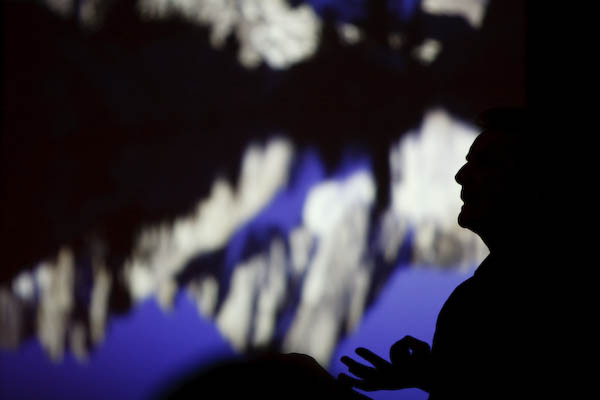Art Wolfe
Creative Sessions Outline
With notes by Fredo Durand

Art in front of a slide
This page is a complement of my notes and review of Art Wolfe's creative session. A summary of each module is on his web site.
Finding your inspiration, discovering the subject.
A. An integrated life
B. Finding your inspiration
C. Discovering the subject
D. Perception
E. The hunt
F. Abstract vs. Literal
Constructing the image
A. Selecting the Viewpoint
A very low or very high viewpoint can be very powerful. Art showed examples where he shot people from above them, which resulted in very graphical and original images.
B. Silent Witness
Shooting people from behind can result in images where one is drawn into the world of the character (animal or human) without appearing to disturb them. It can be more intimate in a sense.
C. Orientation
Sometimes, turning a picture upside-down makes it more dynamic, especially for hanging objects.
D. Conveying scale
Adding a reference such as a human or house can provide a sense of scale. Whether you want to convey or hide scale is another question.
E. Selecting the lens
1. The wide angle lens
a. finding a strong foreground
b. directing the eye
Using foreground graphical elements such as lines to guide the gaze.
c. conveying vastness
2. The small lens
Art does not do a lot of real macro but does what he calls still life.
a. Still life
b. Macro lens
c. Extreme Close up
3. The telephoto lens
a. Simple composition
He showed a successions of images of the geyser in Yellostone where he eventually only shows a branch with a nice shape with the colors in the background.
b. Compressing the composition
F. Selecting the shutter speed
1. Fast shutter speed
a. Freezing the motion
He called tad sharp images of wildlife that freeze motion 'trophies'. He's still proud to have caught them but that's not as much his cup of tea anymore.
b. The Decisive moment
Good old Cartier Bresson's notion that a fraction of a second before or after and the shot is not as good. Art showed, in particular, a striking picture of a whale about to breach, right beneath the surface of the sea.
2. Slow shutter speed
a. Motion blur
b. Contrast Between Fast and Slow
c. Panning with the subject
d. Time Lapse
He has pretty cool time lapse images of night skys.
e. Long Time Exposure
He uses ridiculously long exposures, hours, in particular at night. He does 'painting with light' and showed a cactus with the circular star trails where he illuminated the cactus with a flash light while the stars are an 8-horu exposure. He also showed an 8-hour exposure in Namibia (cover of one of his calendars I think) where he had to program the shot because you're not allowed to be in the park at night. He prayed that no hyena would come damage his equipment!
G. Selecting Focus
1. Shallow Depth of Field
Surprisingly, this is an effect he has only recently discovered. I guess it's not surprising given his style of images, but still.
2. Great Depth of Field
3. Swing and Tilt Lens
He manages to get focus from 30cm till infinity at f/11 thanks to tilt lenses (which he calls swing).
H. Selecting the Backdrop
1. Black Backdrop
In particular when you shoot close subjects like chameleon, the flash can overpower everything and make the background black. He used black backgrounds a lot when shooting tribal people because the lighting conditions where not great and he wanted to create formal graphical portraits.
2. White Backdrop
It is in particular possible to get a pure white background with an out-of-focus overexposed sky.
I. Exposure Control
1. Graduated ND filter
He goes all the way up to a four-stop graduated ND. This really shows in some of his shots.
2. Combining two exposures
He does that manually in photoshop, no HDR merging. In fact, he has assistants who combine them for him.
3. Polarizer
He has a polarizer almost always on, except if he really needs the extra speed.